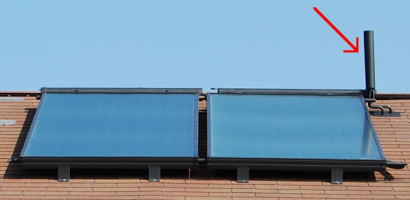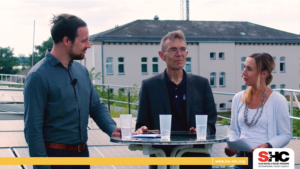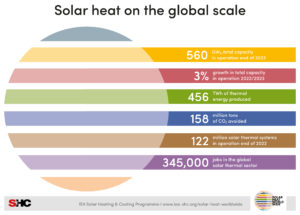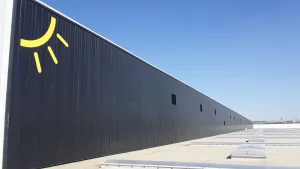USA: Geyser Pump Drives Sunnovations’ Solar System
December 12, 2011
 So far, the alternative to a pumped solar system has been a natural circulation system, also referred to as a thermosyphon system. Virginia-based Sunnovations has now developed a system with a so-called geyser pump – see the chimney-like black stack at the highest point of the solar circuit. As with natural circulation systems, the system is completely self-regulating. And in the same way as a pumped system, it allows to install the tank several storeys lower – in the basement.
So far, the alternative to a pumped solar system has been a natural circulation system, also referred to as a thermosyphon system. Virginia-based Sunnovations has now developed a system with a so-called geyser pump – see the chimney-like black stack at the highest point of the solar circuit. As with natural circulation systems, the system is completely self-regulating. And in the same way as a pumped system, it allows to install the tank several storeys lower – in the basement.
Photo: Sunnovations
Actually, the geyser pump principle is not a completely new technology. It was used in solar thermal systems several decades ago. But those pumps, called Copper-Crickets because of the chirping noise they made, were not scalable and only able to operate as part of one particular type of solar system. This system used methanol as a heat transfer fluid and did not have any overheat protection.
Four years ago, Sunnovations founder Arnoud van Houten became interested in the geyser pump as a promising technology for solar water heating and decided to improve it. In order to avoid confusion: The geyser pump used by Sunnovations is not the pump which has been patented in the US under the designation geyser pump and produced by Geyser Pump Tech. Co. The patent name for Sunnovations’ system is “Adaptive self pumping solar hot water heating system with overheat protection”. As the patent name reveals, the so-called geyser pump is not a separate component – as would be the case with a pump driven by electricity – but a part of an integrated thermal actuating system. In late 2010, Sunnovations started selling it and by now, there are 75 systems in operation.
In the Sunnovations system, the solar circuit works in a vacuum. This reduces the boiling point of the fluid to 40 °C (100 °F). When the temperature is reached, steam bubbles form inside the collector fluid. The steam bubbles force the surrounding fluid up towards the exit tube in the vertical stack of the Sunnovations pump (see picture). This process is similar to the eruption of a geyser. The fluid will be caught in the mouth of the surrounding vertical tube, which leads to the storage tank. Having just erupted from the exit tube, the fluid is at the highest point of the system. The circulation in the solar loop is triggered by the level difference of the fluid in the hot and cold pipe in the stack, which even lets the hot fluid circulate through the tank’s heat exchanger (see the video at the link below).
The maximum working temperature of the system is 85 °C (185 °F). The tank itself will not get hotter than 80 °C (180° F). This allows the integration of low-cost PEX tubes commonly used for radiant heating and drinking water installations. Sunnovations offers an entire range of system kits, including tanks and collectors from OEM manufacturers. The system works with standard tanks and standard collectors as long as they have a harp type absorber.
To prevent overheating, the system also has a passive protection system. If the fluid returning to the collector reaches a temperature above 60 °C (140 °F) – which happens when the tank is fully heated – the pressure in the system exceeds ambient pressure. This will push the fluid out of the collector through a pressure valve into an overflow reservoir (steam-back mechanism at safe ambient pressure). Once the collectors have cooled down, all the fluid is drawn back into the system by the forming vacuum. The overflow reservoir has also been equipped with a one-way valve through which air that might have entered through micro-leaks is purged out of the system.
According to Matthew Carlson of Sunnovations, installation costs are already lower than for a comparable pumped system, as the system needs no electrical pumps and control devices.
To further reduce labour costs, Sunnovations also promises an easier installation because of fewer parts to install. According to the company, system installation requires only standard tools. “A vacuum pump is not needed,” Carlson says.
“Sunnovations’ goal is to drive down installed system costs to around USD 5,000 on the national market, for a system with 6 m2 (64 sq ft) of collector area and a 300 litre (80 gallon) storage tank,” says Carlson.
More information:
Company´s website: http://www.sunnovations.com
Video of Sunnovations’ geyser pump


